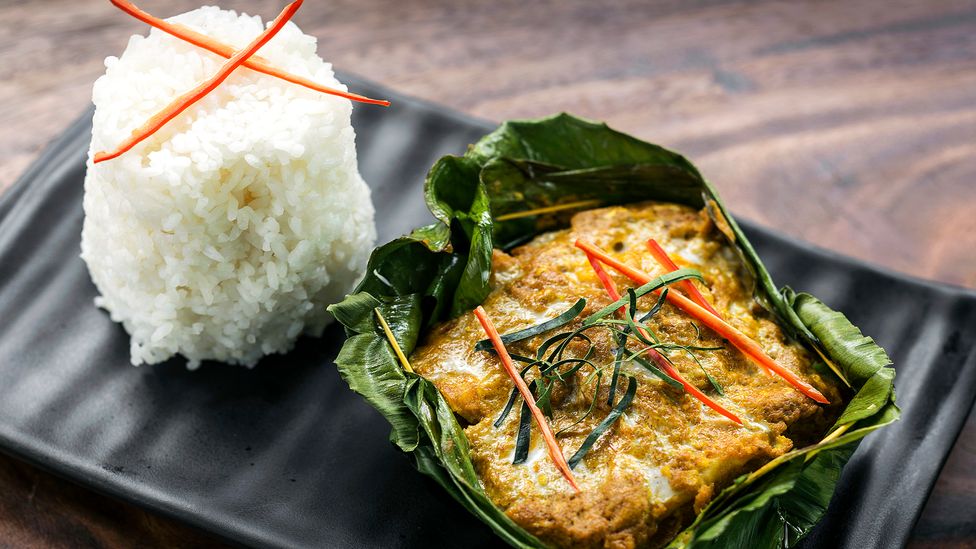Prahok is a fermented fish paste that is widely used as a seasoning and a condiment in Cambodian cuisine. It has a strong smell and a salty flavor that enhances the taste of many dishes, such as soups, curries, dips, and salads. Prahok is considered the key to Khmer cuisine, as it provides protein, flavor, and identity to the Cambodian people.
The History of Prahok
Prahok has been a part of Cambodian culture and history since the Angkorian period (9th-15th centuries), when the Khmer Empire ruled most of Southeast Asia and built the magnificent temples of Angkor. Prahok was originally a way to preserve fish during the dry season, when fresh fish was scarce and expensive. The Khmer people used a local freshwater fish called trey riel (Siamese mud carp) to make prahok, as it was abundant and cheap in the Mekong River and the Tonle Sap Lake.
The process of making prahok involved removing the head, guts, and scales of the fish, then crushing them with their feet in large wooden tubs. The fish pulp was then dried in the sun for a day, then salted and stored in jars or baskets. The fermentation process could take from a few weeks to several months, depending on the desired texture and flavor.
Prahok was not only a food item, but also a form of currency and trade in ancient Cambodia. The trey riel fish was so important that it became the name of the Cambodian currency: riel. People from the inland areas would travel to the riverbanks or the lake shores to buy prahok or exchange it for rice or other goods. Prahok was also exported to neighboring countries, such as Thailand, Laos, and Vietnam.
Prahok survived through centuries of war, invasion, and colonization that affected Cambodia. However, it faced its greatest threat during the Khmer Rouge regime (1975-1979), which tried to eradicate all forms of religion and culture in Cambodia. Thousands of people were killed or starved to death under the brutal rule of Pol Pot and his followers. Prahok was banned and destroyed by the regime, as it was seen as a symbol of the old society.
Prahok was revived after the fall of the Khmer Rouge regime, with the help of surviving families, refugees, and international organizations. Prahok regained its status as a staple food and a cultural heritage of Cambodia. Prahok is now produced in various regions of Cambodia, using different types of fish and ingredients. Prahok is also celebrated in festivals and ceremonies throughout the year.
The Significance of Prahok
Prahok is not only a food item, but also a source of identity and pride for Cambodians. Prahok represents the essence of Khmer cuisine, as it provides protein, flavor, and diversity to many dishes. Prahok is also a symbol of Khmer culture and history, as it reflects the creativity, resilience, and spirituality of the Cambodian people.
Prahok is used in various ways in Cambodian cuisine, such as:
- As a seasoning: Prahok is added to soups, curries, stir-fries, and other dishes to give them a rich and savory taste. Prahok can also be mixed with other ingredients, such as garlic, chili, sugar, lime juice, etc., to create different sauces or dips.
- As a condiment: Prahok is eaten raw or cooked with fresh or cooked vegetables, such as cucumber, eggplant, cabbage, etc. Prahok can also be eaten with rice or rice cakes as a simple meal or snack.
- As a main dish: Prahok can be cooked with meat or seafood, such as pork, chicken, shrimp, etc., to create various dishes that are served with rice or noodles. Some examples are prahok ktis (a spicy pork dip), prahok chien (fried prahok balls), prahok kroeung (prahok with curry paste), etc.
Prahok is also an expression of gratitude and respect in Cambodian culture. Prahok is often offered to monks or elders as a sign of reverence and appreciation. Prahok is also shared among friends or relatives as a sign of friendship and hospitality. Prahok is also enjoyed during festivals or ceremonies as a sign of celebration and joy.
I hope this article was helpful for you. If you have any questions or feedback, please let me know. blush
List of references:
• BBC


